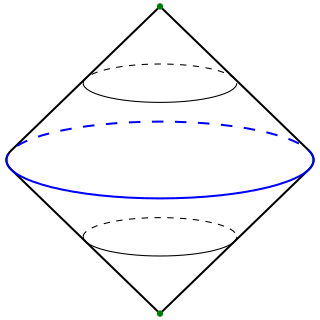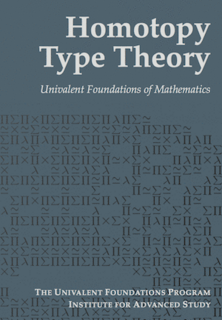
In topology, two continuous functions from one topological space to another are called homotopic if one can be "continuously deformed" into the other, such a deformation being called a homotopy between the two functions. A notable use of homotopy is the definition of homotopy groups and cohomotopy groups, important invariants in algebraic topology.
In mathematics, homotopy groups are used in algebraic topology to classify topological spaces. The first and simplest homotopy group is the fundamental group, which records information about loops in a space. Intuitively, homotopy groups record information about the basic shape, or holes, of a topological space.
In topology, a branch of mathematics, a fibration is a generalization of the notion of a fiber bundle. A fiber bundle makes precise the idea of one topological space being "parameterized" by another topological space. A fibration is like a fiber bundle, except that the fibers need not be the same space, nor even homeomorphic; rather, they are just homotopy equivalent. Weak fibrations discard even this equivalence for a more technical property.
In topology, a CW complex is a type of topological space introduced by J. H. C. Whitehead to meet the needs of homotopy theory. This class of spaces is broader and has some better categorical properties than simplicial complexes, but still retains a combinatorial nature that allows for computation.
In homotopy theory, the Whitehead theorem states that if a continuous mapping f between CW complexes X and Y induces isomorphisms on all homotopy groups, then f is a homotopy equivalence. This result was proved by J. H. C. Whitehead in two landmark papers from 1949, and provides a justification for working with the concept of a CW complex that he introduced there. It is a model result of algebraic topology, in which the behavior of certain algebraic invariants determines a topological property of a mapping.

In topology, the suspension of a topological space X is intuitively obtained by stretching X into a cylinder and then collapsing both end faces to points. One views X as "suspended" between these end points.
In mathematics, the homotopy category is a category built from the category of topological spaces which in a sense identifies two spaces that have the same shape. The phrase is in fact used for two different categories, as discussed below.
In mathematics, particularly in homotopy theory, a model category is a category with distinguished classes of morphisms ('arrows') called 'weak equivalences', 'fibrations' and 'cofibrations'. These abstract from a conventional homotopy category of topological spaces or of chain complexes, via the acyclic model theorem. The concept was introduced by Daniel G. Quillen (1967).
In homotopy theory, a branch of mathematics, a Quillen adjunction between two closed model categories C and D is a special kind of adjunction between categories that induces an adjunction between the homotopy categories Ho(C) and Ho(D) via the total derived functor construction. Quillen adjunctions are named in honor of the mathematician Daniel Quillen.
In mathematics, Out(Fn) is the outer automorphism group of a free group on n generators. These groups play an important role in geometric group theory.
In algebraic geometry and algebraic topology, branches of mathematics, A1homotopy theory is a way to apply the techniques of algebraic topology, specifically homotopy, to algebraic varieties and, more generally, to schemes. The theory is due to Fabien Morel and Vladimir Voevodsky. The underlying idea is that it should be possible to develop a purely algebraic approach to homotopy theory by replacing the unit interval [0, 1], which is not an algebraic variety, with the affine line A1, which is. The theory requires a substantial amount of technique to set up, but has spectacular applications such as Voevodsky's construction of the derived category of mixed motives and the proof of the Milnor and Bloch-Kato conjectures.
In mathematics, especially homotopy theory, the homotopy fiber is part of a construction that associates a fibration to an arbitrary continuous function of topological spaces f : A → B. It is dual to the mapping cone.
In mathematics, the surgery structure set is the basic object in the study of manifolds which are homotopy equivalent to a closed manifold X. It is a concept which helps to answer the question whether two homotopy equivalent manifolds are diffeomorphic. There are different versions of the structure set depending on the category and whether Whitehead torsion is taken into account or not.
In mathematics, assembly maps are an important concept in geometric topology. From the homotopy-theoretical viewpoint, an assembly map is a universal approximation of a homotopy invariant functor by a homology theory from the left. From the geometric viewpoint, assembly maps correspond to 'assemble' local data over a parameter space together to get global data.

In mathematical logic and computer science, homotopy type theory refers to various lines of development of intensional type theory, based on the interpretation of types as objects to which the intuition of (abstract) homotopy theory applies.
In mathematics, a weak equivalence is a notion from homotopy theory which in some sense identifies objects that have the same "shape". This notion is formalized in the axiomatic definition of a model category.
In mathematics, more specifically in homotopy theory, a simplicial presheaf is a presheaf on a site taking values in simplicial sets. Equivalently, a simplicial presheaf is a simplicial object in the category of presheaves on a site. The notion was introduced by A. Joyal in the 1970s. Similarly, a simplicial sheaf on a site is a simplicial object in the category of sheaves on the site.
This is a glossary of properties and concepts in algebraic topology in mathematics.






